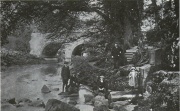Standing Stone (destroyed): OS Grid Reference – NO 486 339?
Archaeology & History
The only reference I can find about this site is in A.J. Warden’s (1880) massive survey of the county of Angus—previously called ‘Forfarshire’—where, in his discussion of the hillforts of the area, he told us that,
“About a quarter of a mile distant from The Laws is the Gallow Hill of Ethiebeaton. In a field, a little to the south, there formerly stood a large upright stone called Tods Stone.”
All trace of it disappeared when quarrying operations were undertaken there, also destroying a number of prehistoric tombs close by. The monolith may have had some association with the tombs, but we cannot be certain.
The name of the stone, tods, probably derives from the word ‘foxes’, although we cannot be certain of this either, as there are a variety of other Scottish dialect words relating to ‘tod’that may have had bearing on the name.
If anyone has any further information about this long lost site, we would gladly welcome it.
References:
- Grant, William (ed.), The Scottish National Dictionary – volume 9, SNDA: Edinburgh 1973.
- Warden, Alex J., Angus or Forfarshire – volume 1, Charles Alexander: Dundee 1880.
© Paul Bennett, The Northern Antiquarian
